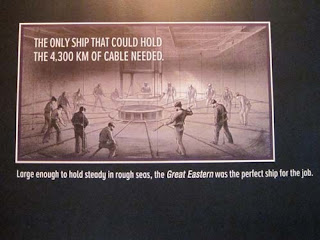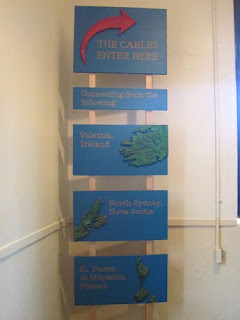Location: Heart's Content, Newfoundland, Canada
Address: NL-80
Date: June 2017
Website: www.seethesites.ca
In these days of cellphones and unlimited internet access it is hard for some to imagine a time when communication was a luxury. Transmitting a message from Canada to Europe used to be an impossibility. A small town in Newfoundland played a big part in making the impossible a reality. We visited Heart's Content to see where history was made.
Across the road from the Heart's Content Cable Station are a few monuments which explain how it all came to be.
In 1858 there was an attempt to lay a cable for transmitting telegraph messages between Newfoundland and Ireland. The photo above shows the two nations shaking hands. Two steam boats, the Niagara and the Agamemnon met and joined the cable. Messages were sent between Queen Victoria and President Buchanan, but the cable failed shortly afterwards.
A huge ship called the SS Great Eastern was built. It was designed to be a cruise ship and could hold 4000 passengers. It proved to be too expensive and too big to keep operating as an ocean liner. It found new life as a cable layer since it could hold the 4300 km of cable needed to make the cross-Atlantic attempt once more.
This time the attempt was a success. There was now a cable between Heart's Content and Valencia Ireland. With the telegraphic cable in place, Heart's Content became a busy communications hub and life was very good there.
Inside the station we visited the cable operating room. It was filled with equipment used for transmitting and receiving messages. At the peak of its operations, it also would have been filled with staff handling the equipment.
There would have been operators switching cables to make connections as well as groups transmitting or re-transmitting messages.
They would have transmitted these messages using morse code. Above is an original morse code sheet as well as a re-typed one to make it easier for visitors to read. See if you can use the information above to decipher this message.
In order to get the messages across the Atlantic Ocean, there are submerged repeaters which do just what their name implies. They take a message received and repeat it. This keeps the signal strong and allows it to be more easily interpreted at the opposite end.
More and more cables were added to the network and the Heart's Content cable station ran until 1965 when newer technologies made it obsolete. The station now stands as a reminder of how it changed the world.
From there they ran towards the water where a morse code plaque reads "Between England and the continent".
More and more cables were added to the network and the Heart's Content cable station ran until 1965 when newer technologies made it obsolete. The station now stands as a reminder of how it changed the world.
The box above is where the cables entered the station.
On the beach across the road some of the cables still remain.
From there the cables headed across the ocean floor past the Heart's Content candy striped lighthouse and into the open ocean. Somewhere thousands of miles away the message was received. An amazing feat for its time.
Map of Our World
 Heart's Content Cable Station
Heart's Content Cable StationPost # 199


















No comments:
Post a Comment
Thanks for reading.
Feel free to leave a comment or question here.